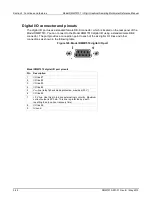
Model DMM7510 7½ Digit Graphical Sampling Multimeter Reference Manual
Section 3: Functions and features
DMM7510-901-01 Rev. B / May 2015
3-47
Monitoring internal temperature
You can monitor the temperature difference between the actual internal temperature and the
temperature when auto calibration ran through the panel or by using remote commands. With remote
commands, you can also check the present internal temperature and the internal temperature when
auto calibration was last run. Temperature is returned in Celsius (°C).
The internal temperature is not updated on the Calibration screen until the warmup period is
complete. The remote commands always return the present temperature.
From the front panel:
1. Press the
MENU
key.
2. Under System, select
Calibration
.
3. The Temperature Difference is displayed.
Using SCPI commands:
For the present internal temperature, send:
:SYSTem:TEMPerature:INTernal?
For the temperature difference, send:
:ACAL:LASTrun:TEMPerature:DIFFerence?
For the temperature when auto calibration was last run, send:
:ACAL:LASTrun:TEMPerature:INTernal?
Using TSP commands:
For the present internal temperature, send:
print(localnode.internaltemp)
For the temperature difference, send:
print(acal.lastrun.tempdiff)
For the temperature when auto calibration was last run, send:
print(acal.lastrun.internaltemp)
Digital I/O
The Model DMM7510 digital I/O port provides six independently configurable digital input/output lines.
You can use these lines for digital control by writing a bit pattern to the digital I/O lines. Digital control
is used for applications such as providing binning codes to a component handler. Digital control uses
the state of the line to determine the action to take.
You can also use these lines for triggering by using the transition of the line state to initiate an action.
The instrument can generate output trigger pulses and detect input trigger pulses. Triggering is used
for applications such as synchronizing the operations of a measure instrument with the operations of
other instruments.
You cannot configure or directly control the digital I/O lines from the front panel. To configure and
control any of the six digital input/output lines, you need to send commands to the Model DMM7510
over a remote interface. You can use either the SCPI or TSP command set. See Remote
communications interfaces for information about setting up a remote interface and choosing a
command set.






























